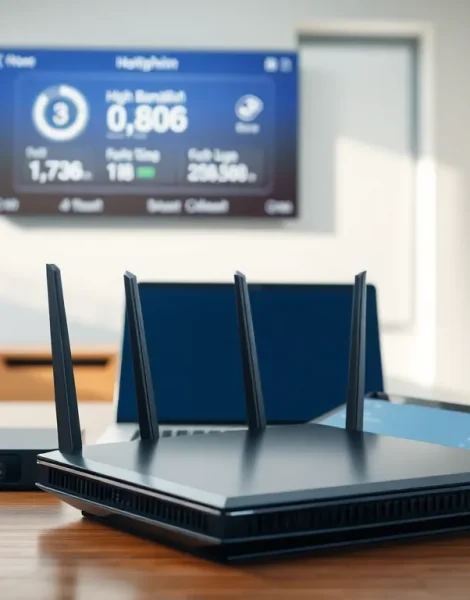Imagine this: you’re binge-watching your favorite show, and the video suddenly freezes. You look over to see your Wi-Fi router blinking furiously like it’s auditioning for a disco. Frustrating, right? Well, welcome to the world of home networks, a magical land where connectivity reigns supreme, but chaos lurks just around the corner. Today, we’re diving deep into home networking solutions to help you tame that chaos and turn your home into a tech-savvy haven.
Table of Contents
ToggleUnderstanding Home Networking

Home networking refers to connecting multiple devices within your household. This setup allows devices like computers, smartphones, smart TVs, and game consoles to communicate with each other and access the internet. Think of it as a digital web spun throughout your home, ensuring your devices can share information seamlessly. From simple connections to complex systems, understanding the basics is crucial for smooth operation.
When delving into this realm, one must also grasp the significance of bandwidth and speed. How many users are on the network? Are they streaming movies or just browsing social media? Answering these questions will determine the kind of home networking solution that’s optimal for any household.
Types of Home Networking Solutions
Navigating the maze of home networking solutions can be daunting. But fear not. Here’s a breakdown of the most common types:
Wired Networks
Wired networks use Ethernet cables to connect devices directly to a router. This setup often guarantees faster speeds and more reliable connections, ideal for gamers or anyone working with large files.
Wireless Networks
If the idea of tangled cords makes you cringe, wireless networks are your best bet. Wi-Fi technology allows devices to connect without cables, bringing flexibility and convenience. But, interference and range can sometimes be problematic, especially in larger homes.
Mesh Networks
For those with a larger home, mesh networks present an interesting alternative. A series of interconnected nodes work together to cover wider areas, eliminating dead spots. This method is particularly helpful in sprawling spaces, ensuring seamless connectivity no matter where one roams.
Key Components of a Home Network
To build a robust home network, a few key components are essential:
- Router: This device directs internet traffic throughout the network, acting as the brain of the operation. Look for one with the latest technology, like WPA3 security and dual-band functionality.
- Modem: It connects to your internet service provider (ISP) and translates signals so your router can make sense of them. Some routers come with built-in modems, simplifying the setup.
- Cables: For wired networks, high-quality Ethernet cables ensure maximum speed and reliability.
- Switch: In larger setups, a switch expands the number of available ports, allowing more devices to connect.
- Access Points: These devices can be added to extend Wi-Fi coverage, particularly in larger homes where the signal might drop off.
Setting Up Your Home Network
Setting up a new home network can feel like assembling IKEA furniture without instructions, overwhelming, to say the least. But, breaking the process down into easy steps can simplify things significantly:
- Choose Your Equipment: Based on your needs, select a quality router and modem. Research brands and read reviews to find the best fit.
- Position Your Router Strategically: Place your router in a central location, away from walls and obstructions. This boosts signal strength throughout your home.
- Connect Your Devices: For wired setups, plug the Ethernet cables into the appropriate ports: for wireless, follow the commands to join the network on each device.
- Secure Your Network: Change the default password immediately to prevent unauthorized access. Don’t skip this step.
- Test Your Network: Use a speed test app or website to gauge performance. Adjust settings as needed.
Best Practices for Home Networking Security
Security can sometimes feel like the elusive pot of gold at the end of the digital rainbow. Here are some best practices to help safeguard your network:
- Change the Default Username and Password: Most routers come with factory default credentials that are easy to guess. Make it a priority to customize these settings.
- Carry out WPA3 Security: This encryption standard is currently one of the best available. It’s worth ensuring your router supports it.
- Create a Guest Network: For visitors, setting up a separate network keeps your primary network more secure. This way, you can allow friends to connect without compromising your personal devices.
- Regularly Update Firmware: Like software, router firmware needs updates to patch vulnerabilities. It’s often found in the management panel.
- Deactivate WPS: Wi-Fi Protected Setup (WPS) can sometimes be exploited, so turning it off adds an extra layer of security.
Future Trends in Home Networking
What does the future hold for home networking? As technology continues to evolve at lightning speed, several exciting trends are emerging:
- Smart Home Integration: The rise of Internet of Things (IoT) devices means that home networks will increasingly need to support numerous smart devices, from fridges to smart speakers.
- AI-Driven Network Management: Artificial intelligence is entering the fray. Future routers may autonomously optimize traffic and troubleshoot common connectivity issues, making life easier for users.
- Increased Focus on Security: As cyber threats grow more sophisticated, enhanced security features will be paramount in networking solutions. Expect to see router technologies integrating advanced threat detection and prevention.









